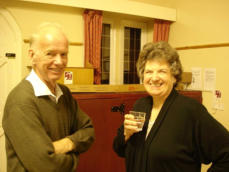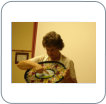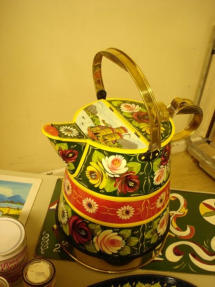

April 2020





Sue Woodward
Sue Woodward gave a most interesting talk which was attended by a number of
canal enthusiasts and artists as well a members of the Heritage Society. She explained
how she had become interested in the canals over 30years ago as the result of a canal
boat trip to convalesce after a serious illness. As an artist she was particularly
interested in in the very characteristic “Roses and Castles” canal style of art, she started
to research its origins and took up painting herself.
Origins It is not clear how canal painting arose. It is thought, it first appeared in the
1850’s, perhaps as a result of wives moving onto the boats with their husbands and
wanting to bring some decoration from the parlour at home. With a small cabin with
sloping walls it was impractical to hang pictures, so images were painted directly on the
boat. It could also be that owners took a pride in their boat and wanted to make it
more impressive. The pictures were painted in the boatyard when a boat went in for
repairs or repainting. The pictures were created by “painters” not “artists”.
Styles Individual boatyards and areas had distinctive styles eg a Southern Stle or a
Northern Style; the Braunston Boatyard (Southern Style!) being particularly famous.
The basic designs and style of painting are seen in Austria and Switzerland and right
across Eastern Europe into Russia. See some examples of Russian Painted Objects.
Sue Woodward learnt her trade by attending a number of Master Classes with

acknowledged experts in the field as well as hard practice. She is a member of the Waterways Craft Guild initially with the rank
of Journeyman, but has recently been elevated to the status of Senior Journeyman. She exhibits and sells her wares each year at
the Crick Boatshow.
Sue demonstrated the techniques for painting a plate and a watercan. The important thing with a galvanised watercan is
preparation of the base metal zinc surface: degrease, sand the surface, treat with mordant and then a good primer (if this is not
done the paint will peel off). A base coat is then applied and the image painted with each layer being applied whilst the
preceding layer is still wet to give a characteristic appearance to the image. Images are painted with matt paint and the final
image is varnished to protect it and give a gloss finish. As an example, a large watercan took over 24hours work to complete.








Blisworth Heritage Society © 2020

















